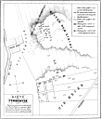The Germanic death camp near Selzen in the province of Rheinhessen
The Germanic death camp near Selzen in the province of Rheinhessen is the title of a research-historical monograph by the brothers Wilhelm and Ludwig Lindenschmit . In the work grave connections and finds from the early medieval burial ground of Selzen are presented. The work was published by Victor von Zabern in Mainz in 1848 .
The burial ground
The cemetery of Selzen is a Merovingian period cemetery, it was located in the "Die Heuer" and "Behind the Church" trays east of the Selzbach and the former Selzer mill. In the northern part ( 49 ° 51 ′ 35.3 ″ N , 8 ° 15 ′ 25.6 ″ E ), earth graves have been observed, in the southern area ( 49 ° 51 ′ 32 ″ N , 8 ° 15 ′ 27.7 ″ E ) the burials were framed with stone slabs. Grave goods were almost exclusively found in the earth graves in the north.
Documentation and publication
The results of excavations from the years 1845 and 1846 are particularly important in the publication. Burials in the area of the burial ground had already been destroyed beforehand. According to the local teacher Krafft, L. Lindenschmit excavated seven graves in 1845, followed by further excavations in 1846. While only grave 2 was documented in drawings in 1845, colored drawings of 21 earth graves were made and published in the following year. In addition to the description and drawing of the individual grave goods, the findings were also described in context, for example the location of the individual finds or other special features such as preserved textile prints on metal. In addition, a brief catalog of the individual graves and a grave field map was created. With this, essential elements of a modern cemetery template are already fulfilled.
Research historical significance
Before the discovery of the Selzen cemetery, archaeological finds from the Merovingian period could not be dated beyond doubt to the early Middle Ages . In grave 12 and grave 17 of Selzen, coins from Justinian I (ruled from 527 to 565 AD) were discovered as grave obolus in the mouth area, the term post quem of which enabled an unequivocal chronological classification. In this respect, the publication is an important step in researching this epoch.
With the help of coin dating as well as typological comparisons of burial customs and additions, for example with the ax (a so-called Franziska ) from the grave of the Frankish king Childerich I , as well as other iron weapons of men such as spathes or saxes , clothing accessories and jewelry of women such as Bow brooches and disc brooches and style comparisons of the decorative elements on pieces of jewelery could also be dated to other well-known early medieval cemeteries such as the burial grounds of Oberflacht , Nordendorf, Fridolfingen, Sinsheim, Ehaben or Lausanne Bel-Air. Shortly before, significantly different dates had been proposed for these grave fields. Due to this chronological classification, the buried were also assigned as Teutons. A very violent dispute between so-called “Celtomaniacs” and “Germanomaniacs”, which was based more on the political attitudes of the people than on scientific knowledge, was settled.
Examples
The depicted grave 11 (from 1846) is a female burial from the 6th century with a four-brooched costume with round disc brooches on the shoulders and bow brooches on the knees. The neck and at the wrists was found beaded jewelry . A needle and some small pieces of bronze were found in the upper chest area. An iron buckle lay on the side of the pelvis, two knives and a spindle whorl between the lower legs. A glass tumbler and a wall pot made of clay were deposited next to the feet .
Men's grave 12 includes weapons with a long sword (spathe), short sword (sax), lance and arrows as well as other additions.
The height of both persons measured 7 feet (1.75 m) amazed the excavators.
More drawings
literature
- W. and L. Lindenschmit: The Germanic death camp near Selzen in the province of Rheinhessen. Verlag Victor von Zabern, Mainz 1848 ( digitized 1 , digitized 2 ). Reprinted with a foreword by Kurt Böhner , Verlag Philipp von Zabern, Mainz 1969.
- Ludwig Lindenschmit: Journal of the Association for Research into Rhenish History and Antiquities 1, 1845–1851, pp. 118–119, p. 267, p. 333–344 digitized
- Hermann Ament : Franconian aristocratic graves from Flonheim in Rheinhessen, Berlin 1970
- Hermann Ament: Review: Wilhelm and Ludwig Lindenschmit, Das Germanische Todtenlager bei Selzen (Mainz 1969 = reprint of the first edition 1848) Germania 49, 1971, pp. 274–279
- Alfried Wieczorek: The transition from late antiquity to the early Middle Ages in southern Rheinhessen, University of Mainz, 1985
- Gudula Zeller: Selzen. In: Reallexikon der Germanischen Altertumskunde (RGA). Volume 28, Walter de Gruyter, Berlin / New York 2005, pp. 144–146
- Hubert Fehr: Teutons and Romans in the Merovingian Empire: Early historical archeology between science and contemporary events. In: Reallexikon der Germanischen Altertumskunde - supplementary volumes 68, Walter de Gruyter, Berlin / New York 2010, ISBN 978-3-11-021461-1
Web links
Coordinates: 49 ° 51 ′ 35.3 " N , 8 ° 15 ′ 25.6" E






